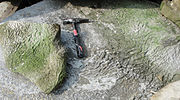paleoecology of the earliest echinoderms: Helicoplacoids and the Cambrian substrate revolution". Geology. 28 (9): 839–842. Bibcode:2000Geo....28..839D. doi:10... 135 KB (15,544 words) - 18:10, 10 April 2024 |
Cambrian substrate revolution All pages with titles beginning with Agricultural revolution All pages with titles containing Agricultural revolution Revolution... 1 KB (184 words) - 12:28, 2 March 2024 |
 | Microbial mat (category Cambrian life) Microbial mats were abundant on the shallow seabed until the Cambrian substrate revolution, when animals living in shallow seas increased their burrowing... 42 KB (4,539 words) - 23:11, 16 January 2024 |
 | Edrioasteroidea (category Cambrian first appearances) were destroyed in the Cambrian substrate revolution. The oldest undisputed fossils of Edrioasteroidea are known from Cambrian (Stage 3, about 515-520... 8 KB (782 words) - 10:41, 9 April 2024 |
This means it must have been well below a centimetre in length. As all Cambrian animals are marine, one can reasonably assume that the urbilaterian was... 14 KB (1,635 words) - 21:21, 18 October 2023 |
 | burrowing, first for protection and later for feeding - the Cambrian substrate revolution. This combination of factors marks the end of the slow-moving... 11 KB (1,290 words) - 13:57, 21 March 2024 |
 | stromatolite builders fell victim to grazing creatures (the Cambrian substrate revolution); this theory implies that sufficiently complex organisms were... 40 KB (3,942 words) - 16:23, 25 March 2024 |
 | Burgess Shale (category Cambrian System of North America) preservation of the soft parts of its fossils. At 508 million years old (middle Cambrian), it is one of the earliest fossil beds containing soft-part imprints.... 23 KB (2,512 words) - 16:38, 25 April 2024 |
microscopic size, making the sudden appearance of many animal phyla in the Cambrian explosion an illusion and merely represented a (geologically) sudden increase... 6 KB (596 words) - 02:24, 27 December 2023 |
assemblages based on taxonomic criteria only. The fauna of the middle Cambrian has a cosmopolitan range. All assemblages preserving soft-part anatomy... 20 KB (2,076 words) - 02:30, 1 October 2023 |
recording conditions up to a good forty to fifty million years before the Cambrian explosion at the beginning of the Phanerozoic. The whole sequence sits... 16 KB (1,814 words) - 07:10, 26 February 2024 |
Burgess Shale-type preservation (category Cambrian fossil record) Cambrian compared to later time periods, which represents a global megabias. The mode of preservation is more abundant before the Cambrian substrate revolution... 40 KB (4,584 words) - 21:28, 10 March 2024 |
 | Maotianshan Shales (category Cambrian System of Asia) The Maotianshan Shales (帽天山页岩) are a series of Early Cambrian sedimentary deposits in the Chiungchussu Formation, famous for their Konservat Lagerstätten... 29 KB (2,887 words) - 16:42, 14 March 2024 |
 | Bell Island a globally unique location for the study of the Cambrian substrate revolution, one of the most important events in the history of life. The... 127 KB (15,355 words) - 07:50, 1 May 2024 |
 | Pambdelurion (category Cambrian arthropods) Pambdelurion is an extinct genus of panarthropod from the Cambrian aged Sirius Passet site in northern Greenland. Like the morphologically similar Kerygmachela... 10 KB (950 words) - 23:13, 6 March 2024 |
paleoecology of the earliest echinoderms: Helicoplacoids and the Cambrian substrate revolution". Geology. 28 (9): 839–842. Bibcode:2000Geo....28..839D. doi:10... 94 KB (9,327 words) - 19:04, 26 April 2024 |
 | Tamisiocaris (category Cambrian arthropods) radiodont genus initially only known from frontal appendages from the Cambrian Sirius Passet lagerstatte in northern Greenland. It was initially described... 3 KB (203 words) - 19:54, 10 February 2024 |
 | Kerygmachela (category Cambrian arthropods) Kerygmachela kierkegaardi is a kerygmachelid gilled lobopodian from the Cambrian Stage 3 aged Sirius Passet Lagerstätte in northern Greenland. Its anatomy... 8 KB (691 words) - 13:54, 15 March 2024 |
Poleta Formation (category Cambrian System of North America) and Nevada. The formation dates to the Stage 3 of the yet-to-be-ratified Cambrian Series 2; the lower portion base of the formation and the youngest Lagerstätte... 4 KB (402 words) - 14:23, 10 February 2024 |
 | the Cambrian explosion. The rapid event finished before 518 million years ago. Some mid-19th century scientists already knew about some Early Cambrian fossils... 6 KB (600 words) - 17:19, 16 May 2023 |
M. (eds.). "Early skeletal fossils" (PDF). Neoproterozoic- Cambrian Biological Revolutions. Paleontological Society Papers. 10: 67–78. Retrieved 2008-07-18... 2 KB (329 words) - 03:29, 14 March 2022 |
 | the matgrounds disappearance. Cambrian substrate revolution Ediacaran matground ecology persisted into the earliest Cambrian, by Luis A. Buatois, Guy M.... 3 KB (275 words) - 11:28, 25 October 2023 |
Kaili Formation (category Cambrian System of Asia) stratigraphic formation which was deposited during the Lower and Middle Cambrian (~513 to 506 million years ago). The formation is approximately 200 metres... 9 KB (852 words) - 11:43, 19 March 2024 |
 | Halkieriid (category Cambrian molluscs) to Middle Cambrian. Their eponymous genus is Halkieria /hælˈkɪəriə/, which has been found on almost every continent in Lower to Mid Cambrian deposits,... 63 KB (6,415 words) - 23:17, 6 January 2024 |






